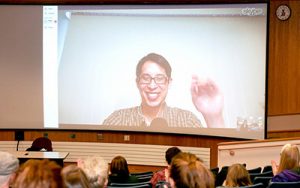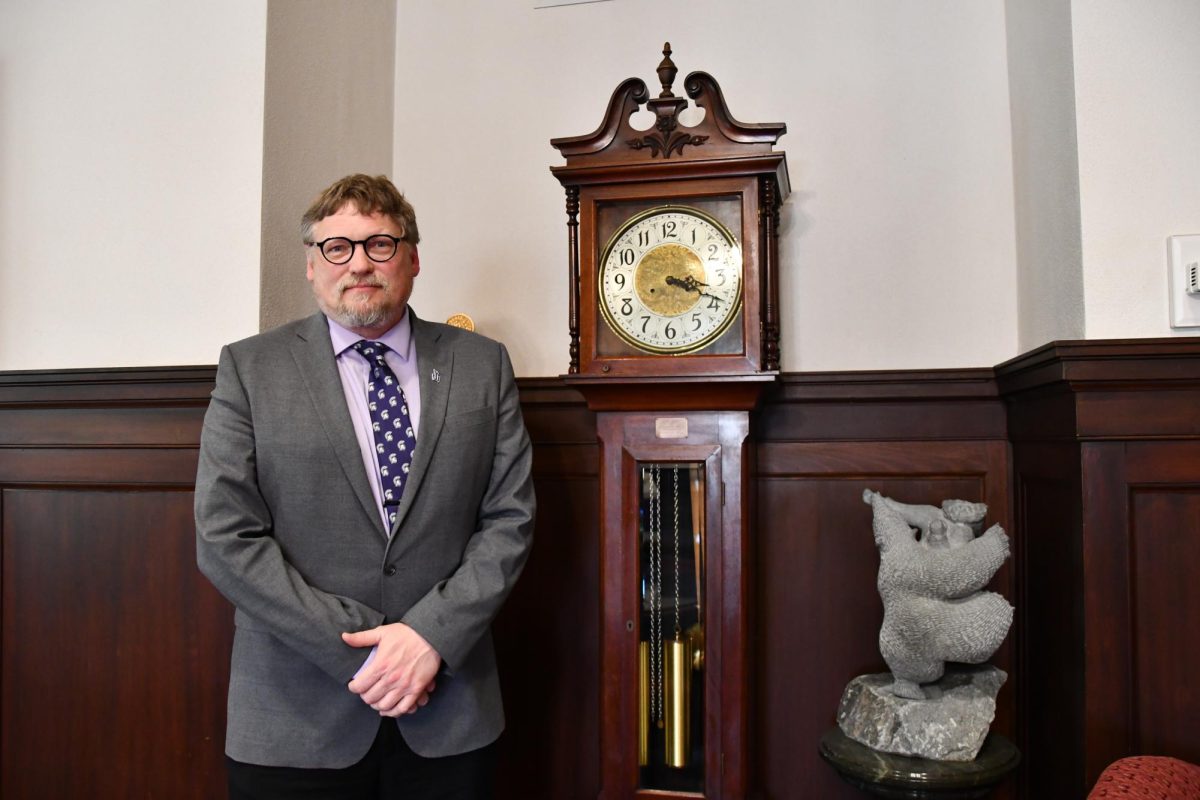
Elizabeth Pulanco / Winonan
Graphic novel author Gene Luen Yang is a busy man.
This January, he was appointed the Ambassador for Young People’s Literature by the Library of Congress and he is also the author of “American Born Chinese,” which was this year’s common book for Winona State University.
On Feb. 10, Yang joined members of the Winona State community via Skype for a Q&A session about the common book, which was published in 2006.
Ann-Marie Dunbar, a professor from the Winona State English department, has been involved with the process of choosing the common books for five years. For Dunbar, being a part of this program is a responsibility she enjoys having.
“It is a lot of responsibility, but it is fun to think about what books might teach well and what opportunities for research will come from different types of books,” Dunbar said.
When finding the common book, members of the committee in charge of choosing the book invite people from the campus community to nominate books for the program.
“We are looking for books that are engaging and authors who are willing to work with the students,” Dunbar said.
After the nominations are made, the committee narrows down the number of books on the list to four or five. After a series of discussions, the final book is chosen.
When deciding on “American Born Chinese,” Dunbar and her colleagues wanted to pick a book that followed the school theme of equity.
“The book focuses on different cultural experiences and uses creative ways to express these cultures,” Dunbar said. “We have also worked with Gene Yang before and he is very engaging with students.”
Yang was born to a Chinese mother and a Taiwanese father. As a child, Yang interacted with his parents through stories and drawing.
Yang’s dream job as a child was being an animator for Disney, but this dream changed in fifth grade when he saw the #99 issue of Marvel’s “Two-In-One” comic on a display rack while at the store with his mother. Yang was intrigued by the comic book and begged his mother to buy it for him, but she got him an issue of “Superman” instead.
“She thought the characters on the cover of the ‘Two-In-One’ comic would give me nightmares,” Yang said.
Shortly after his discovery of comic books, Yang and a childhood friend began writing their own comics.
After graduating college, Yang published his first comic book “Gordon Yamamoto and the King of the Geeks” in 1997.
Along with discussing his creative development and his discovery of comic books, Yang also discussed the participation of Asian Americans in the world of comic books.
Many of the first depictions of Asians were stereotypical and the comic book characters fell into the “yellow peril” trope, which was based on a theory in which Asian individuals are a danger to the western world. Many of these stereotypical characters were villains.
Some students were shocked by the representation of Asians in comic books.
“Seeing how the racism in society effects the depiction of certain people in comic books was shocking, especially since comics could possibly promote these ideas in young minds,” sophomore Merritt Ogren said.
According to Yang, over time the depiction of Asians in comic books became less stereotypical and well-rounded Asian characters were developed.
As an Asian American in the industry himself, Yang was curious about why people of Asian heritage are drawn to comics.
To discover these connections, Yang and some friends developed many theories. One theory is related to traditional Asian art and its use of art and words together. By being exposed to this combination within their heritage, Asian Americans are prepared for working with these elements in comics.
Another theory comes from the origin of comic books themselves. Many comic books and characters were created by the sons of Jewish immigrants. At the time of their creation, these men would have been considered outsiders, and this is something Asian Americans in the comic book industry can identify with.
Even though Yang has received his title from the Library of Congress, he is still very much involved in the world of comics and graphic novels.
For the past four years, Yang has been writing graphic novels about the Nickelodeon television series “Avatar: the Last Airbender.” These graphic novels serve as a continuation of the television series. He has also been working with DC Comics as a writer for several issues of “Superman.”
Exploring different cultures and their impacts on certain mediums can help create more meaningful interactions with this medium. For Gene Luen Yang, bringing his culture into his work with comics and graphic novels not only impacts his life, but it could also spark an idea in the mind of an aspiring Asian-American comic book artist.



























































